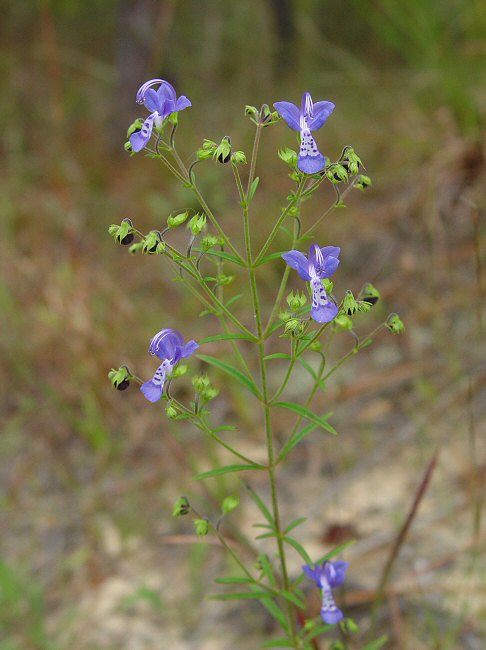Trichostema setaceum Houtt.
Blue Curls

Native
CC = 10
CW = 5
MOC = 2
SRank = S1
© DETenaglia
Trichostema setaceum Houtt.Blue Curls | |
 |
Native CC = 10 CW = 5 MOC = 2 SRank = S1 |
© DETenaglia |
|
Family - Lamiaceae Habit - Annual forb with slender taproot. Stem - Ascending to erect, to 50 cm, slender, bluntly 4-angled, sparsely to densely pubescent with downward-curved, nonglandular hairs.
Leaves - Opposite, simple, entire, sessile to short-petiolate. Blades 1-5 cm long, mostly 1-6 mm wide, linear to narrowly lanceolate, angled or tapered at the base, angled or tapered to a bluntly or sharply pointed tip, the surfaces moderately pubescent with minute, curved, nonglandular hairs, the undersurface also with inconspicuous sessile glands, the venation of a solitary midvein, lacking evident secondary veins.
Inflorescence - Appearing terminal and axillary, usually as open, irregularly branched panicles with leaflike bracts that are smaller than the foliage leaves, the flowers paired at the nodes or in pairs of small, loose clusters or panicles, each with 3-7 flowers. Flowers becoming inverted as the fruits mature.
Flowers - Calyces 3.5-5.5 mm long at flowering, becoming enlarged to 5.0-7.5 mm at fruiting, zygomorphic, 2-lipped, the upper lip with 3 triangular lobes, about 2-3 times as long as the lower lip, which has 2 narrowly triangular lobes, the outer surface densely pubescent with a mixture of minute, gland-tipped and nonglandular hairs, sometimes also with sessile glands. Corollas 5-12 mm long, strongly zygomorphic, the tube funnelform, expanded in the throat, the upper lip with 4, shorter, similar, spreading to slightly inward-arched lobes, these blue to purplish blue, the lower lip with 1, much longer, spreading lobe, this abruptly spreading, usually white below the blue to purplish blue tip, the white portion spotted or mottled with blue to purplish blue. Stamens strongly exserted, the filaments 8-20 mm long, strongly arched downward, the anthers dark blue.
Fruits - Dry schizocarps, separating into usually 4 nutlets, these 1.5-2.1 mm long, yellowish brown to dark brown, glabrous.
Flowering - September - October. Habitat - Sand prairies and savannas, sandy disturbed areas. Origin - Native to the U.S. Lookalikes - T. dichotomum. Other info. - This species is fairly uncommon throughout its range, occuring in scattered locations in the southeastern continental U.S. and ranging as far north as Connecticut. Its presence in Missouri is confined to two counties in the far southeast of the state, where expanses of sandy soils exist. It is currently assigned a conservation ranking of S1 (critically imperiled) within the state of Missouri. The plant looks similar to the far more common T. dichotomum except for having much narrower leaves with only a single midvein and no lateral venation evident on the leaf underside. Photographs taken off Lee Rd 10, Auburn, AL., 9-29-04 (DETenaglia); also at Holly Ridge Conservation Area, Stoddard County, MO, 08-22-2009, and on private lands southeast of Benton, Scott County, MO, 8-30-2011 and 8-28-2015 (SRTurner). |